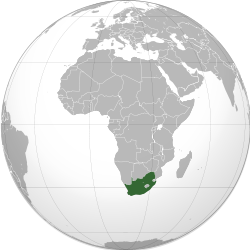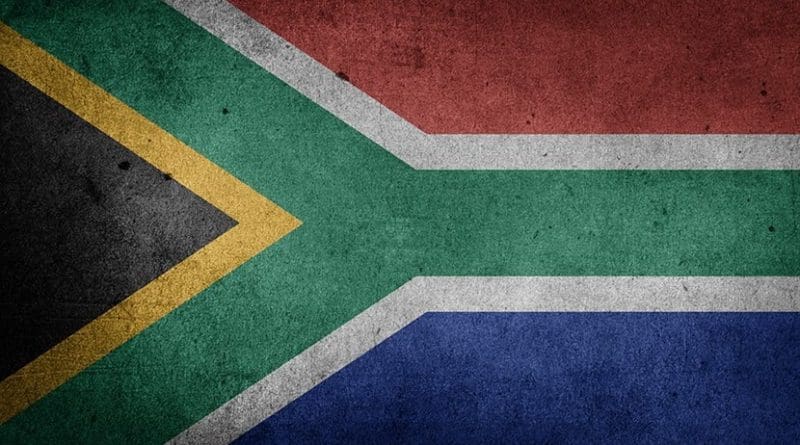South Africa Energy Profile: Significant Coal Consumer And Exporter – Analysis
By EIA
(EIA) — South Africa’s energy sector is critical to the economy as the country relies heavily on its large-scale, energy-intensive mining industry. South Africa has only small deposits of conventional oil and natural gas and uses its large coal deposits for most of its energy needs.
As a result, carbon emission and intensity levels are relatively high.
The country also has a highly developed synthetic fuels industry, producing gasoline and diesel fuels from coal and natural gas.
According to a recent EIA study, South Africa could hold significant shale gas resources. However, the sector is at the early stages of development and exploration plans have been put on hold as a result of environmental concerns that led to a 2011 moratorium on licensing and exploration.

In 2008, according to the International Energy Agency (IEA), South Africa consumed an equivalent of 5.3 quadrillion Btu of total energy. Of this, coal/peat accounted for 71.1 percent of total primary energy supply, followed by oil (12.8 percent), and combustibles, renewables and waste (10.4 percent). South Africa’s energy balance also includes relatively small shares of natural gas, nuclear, and hydroelectricity.
The economy has grown rapidly since the end of the apartheid era in 1994 and is now one of the most developed economies in Sub-Saharan Africa. Despite this rapid growth, economic problems from the apartheid era remain, particularly poverty and lack of economic empowerment among the disadvantaged groups. The South African government has committed to ensuring that black-owned companies have access to the energy sector under its black economic empowerment (BEE) program which sets a target of 25 percent black ownership of energy companies by 2014.
Oil Transit
South Africa’s Cape of Good Hope (Cape) is a significant point for oil tanker transit around the continent. According to Lloyd’s Analysis of Petroleum Exports (APEX) database, in 2010 approximately 3.3 million barrels a day (bbl/d) of oil transited from west to east around the Cape originating mostly from West Africa (1.8 million bbl/d) and the Western Hemisphere (1.2 million bbl/d) and destined for Asian Markets. At the same time, 1.9 million bbl/d, originating mostly in the Middle East, transited west around the Cape to Atlantic Basin markets.
Oil
South Africa has the second largest oil refinery system in Africa and imports the majority of its crude oil from members of the Organization of Petroleum Exporting Countries (OPEC), namely Iran, Saudi Arabia, Nigeria, and Angola.
According to Oil and Gas Journal (O&GJ), South Africa had proven oil reserves of 15 million barrels in January 2011. All of the proven reserves are located offshore southern South Africa in the Bredasdorp basin and off the west coast of the country near the border with Namibia. South Africa has no significant crude oil production but the country did produce slightly over 180,000 barrels per day (bbl/d) of non-conventional, synthetic liquids processed from coal and natural gas (see Synthetic Fuels Section below).
South African oil consumption is estimated to be slightly over 550,000 bbl/d, of which, approximately 370,000 bbl/d is imported (67 percent of consumption). The majority of South African oil imports are from OPEC countries, namely Iran (29 percent), Saudi Arabia (24 percent), Nigeria (19 percent) and Angola (18 percent). The country also imports refined fuels but is planning to increase domestic refining capacity. South Africa is promoting further exploration and development in the petroleum sector but there has been little investment in exploration and there have been no recent commercial discoveries.
Sector Organization
The National Energy Regulator of South Africa (NERSA), created in 2005, regulates policy over the entire South African energy industry and is responsible for implementing South Africa’s energy plan. South Africa’s national oil and natural gas company, the Petroleum Oil and Gas Corporation of South Africa (PetroSA), is active in all the country’s oil and gas projects, often in partnership with smaller international oil companies. The company also has exploration and production activities around the world and operates the Mossel Bay gas-to-liquids (GTL) facilty.
Refining and Downstream
South Africa has the second largest refining capacity in Africa at 703,000 bbl/d of total oil according to a 2010 SAPIA report, surpassed only by Egypt (726,250 bbl/d- O&GJ). Major refineries include Sapref (180,000 bbl/d) and Enref (120,000 bbl/d) in Durban, Chevref (100,000 bbl/d) in Cape Town, and Natref (108,000 bbl/d) at Sasolburg. PetroSA is also developing a new 400,000 bbl/d refinery in the Eastern Cape to meet rapidly growing product demand and limit imports. The new refinery will be designed to process heavy, sour crudes and the project is expected to be launched in 2012.
Refining of Synthetic Fuels from Natural Gas and Coal
Synthetic fuels represent almost all of South Africa’s domestic liquid fuel production. The country has a highly developed synthetic fuels (synfuel) industry, creating liquid fuels from coal and natural gas. State company PetroSA and petrochemicals giant Sasol are the major players. PetroSA manages the world’s largest commercial natural gas-to-liquids plant at Mossel Bay in the Western Cape, with a capacity of 45,000 bbl/d. Sasol, an oil, gas and chemical company, operates the world’s only commercial coal-to-liquids synthetic fuels facility (see Natural Gas and Coal sections for more information.)
Natural Gas
South Africa produces small amounts of natural gas, which it uses in synthetic fuel production.
In 2009, South Africa produced 67 Bcf, of natural gas and consumed 191 Bcf; the remaining 124 Bcf was imported from neighboring Mozambique. South Africa has very limited and declining conventional natural gas reserves but potentially large shale gas resources.
According to recent analysis by EIA and Advanced Resources International, South Africa has 485 Tcf of technically recoverable shale gas resources, most of which are located in the Karoo Basin. The development of these reserves requires investments in exploration and several international companies have obtained permits to explore the region. However, environmental concerns regarding hydraulic fracking, the process through which shale gas is extracted, have led to a moratorium on further permitting and existing licenses are being reviewed.
Any additional natural gas reserves would likely be developed with the intent of extending the supply to the Mossel Bay gas-to-liquids (GTL) plant, which already partially relies on imported natural gas (see below). Infrastructure constraints limit the role of natural gas in the country’s electricity sector but the government plans to increase imports and expand domestic production could diversify the energy mix and offset some of the country’s reliance on coal.
Sector Organization
South Africa has numerous government agencies and companies involved in the natural gas industry, but as with oil and coal, the National Energy Regulator of South Africa (NERSA) is the industry regulator.
Gas-to-Liquids (GTL)
The GTL refinery at Mossel Bay began operations in 2004 and is one of the largest in the world. The refinery has the capacity to process 45,000 bbl/d of oil equivalent through a Fischer-Tropsch Process in which natural gas is converted to synthetic liquid fuels. An overview of the refining process by PetroSA can be found here.
Natural Gas Pipelines
Natural gas from Mozambique is imported through a 535-mile transport pipeline, which Sasol, the South African government, and the government of Mozambique own through a joint venture. The pipeline has a peak capacity of 524 million cubic feet per day (MMcf/d) of natural gas and was part of a $1.2-billion natural gas project started in 2004. It is designed eventually to be able to transport double its current capacity. The imported gas is destined for the Mossel Bay GTL facility.
Coal
South Africa has the world’s ninth largest recoverable coal reserves.
South Africa’s economy is heavily dependent on coal. According to EIA, South African coal resources were estimated to be approximately 33 billion short tons in 2008, accounting for 95 percent of African coal reserves and close to 4 percent of world reserves. Coal accounted for over 90 percent of the country’s electricity generation in 2008 and is also a major feedstock for the country’s synthetic fuel industry.
Production and consumption of coal has remained relatively stable over the past decade. In 2010, the country produced an estimated 276 million short-tons and consumed 201 million short tons (MMst). The remaining 75 MMst were exported, mostly to China, India, and Europe.
Environmental groups continue to target the industry for air, land, and water pollution through all of the industry’s stages from extraction to end use. Nonetheless, coal use – especially by Eskom (the state electricity company) and Sasol – is expected to continue or even accelerate over the next few years. Eskom is in the process of returning to service three coal-fired power stations (Camden, Grootvlei and Komati) with a combined capacity of 3,800 megawatts (MW). It has also begun construction of the new 4,800 MW Medupi power station, whose first unit is due to begin generation in 2012.
Coal-to-Liquids (CTL)
In addition to power generation, the country produces synthetic fuels from low-grade coal and a small amount from natural gas. At the Sasol synfuels plant in Secunda, around 45 million short tons a year are converted into liquid fuels, gas, and other products. The plant itself produces an estimated 150,000 bbl/d of oil equivalent and is the world’s only commercial coal-to-liquids plant in operation. Sasol is also planning to expand CTL capacity.
Electricity
Rapidly increasing electricity demand in South Africa has led the government to set out ambitious plans to expand the sector.
Despite having reached a 75 percent electrification rate nationwide, the highest in Sub-Saharan Africa, only 55 percent of the rural population has access to electricity (compared to 88 percent in urban areas). According to 2009 IEA data, these figures indicate that approximately 12.5 million people had no access to electricity.
Electricity demand continues to rise in South Africa and in recent years, has outstripped the available supply infrastructure to the point where the country suffered rolling blackouts, although improvements have taken place. The country’s 2010 electricity strategy lays out plans to work on the country’s electricity distribution structure and fast-tracking projects by independent power producers. There is also a considerable amount of investment in new power projects with targeted capacity additions of over 40,000 MW by 2030, which will include mostly coal but also renewable and nuclear generating capacity.
In the short-term, three coal fire power stations have been re-commissioned (see below) and plans are underway for another 4,700 MW coal-fired plant (Medupi) as well as a 3,500 MW nuclear power station, the latter having been delayed for financial reasons as well as possible security concerns following Fukushima. To meet generation targets, and as a demand-side measure, electricity rates have been gradually increasing for all sectors, causing concern among the more energy-intense industries as well as poorer households.
Eskom generates about 95 percent South Africa’s electricity, mainly from coal fired plants. According to the company website, in 2008 Eskom had a total generation capacity of 50.2 gigawatts (GW), 85 percent of which is from coal fired plants (42.5 GW including return-to-service and new build plants). Close to 7 percent of the country’s generating capacity is from the Koeberg Nuclear Power Station. South Africa also exports electricity to neighboring countries through the Southern African Power Pool (SAPP).
Sector Organization
The electricity sector falls under the regulation of the National Energy Regulator of South Africa (NERSA) which replaced that National Electricity Regulator. Eksom is responsible for transmission and generates almost all of South Africa’s electricity. NERSA is promoting private sector participation by encouraging investment on the part of independent power producers (IPPs), who already account for a small share of the country’s electricity generation, as well as promoting off-grid technologies to meet rural energy needs.

